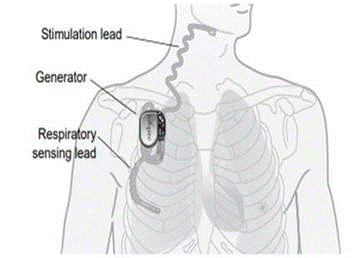Inspire® Upper Airway Stimulation – P130008/S039
This is a brief overview of information related to FDA’s approval to market this product. See the links below to the Summary of Safety and Effectiveness Data (SSED) and product labeling for more complete information on this product, its indications for use, and the basis for FDA’s approval.
Product Name: Inspire® Upper Airway Stimulation (UAS)
PMA Applicant: Inspire Medical Systems, Inc.
Address: 5500 Wayzata Blvd. Suite 1600
Golden Valley, MN 55416 US
Approval Date: April 14, 2020
Approval Letter: Approval Order
What is it? The Inspire® Upper Airway Stimulation (UAS) system is an implantable nerve stimulator used to treat moderate to severe obstructive sleep apnea (OSA). The Inspire® UAS system consists of implanted components including the implantable pulse generator (IPG), stimulation lead, and sensing lead and external components such as the physician programmer and the patient programmer.
This approval expands the indications for use of the Inspire® UAS in patients between the ages of 18 and 21with moderate to severe OSA who:
- Do not have complete blockage of the upper airway
- Are not able, or not effectively treated by, the removal of tonsils and other soft tissue behind the nose
- Have been confirmed to fail, or cannot tolerate, PAP therapy despite attempts to improve compliance
- Have followed standard of care in considering all other alternative/adjunct therapies
How does it work? The implantable pulse generator detects the patient’s breathing pattern and maintains an open airway with mild nerve stimulation. The physician is able to configure the stimulation settings using the external physician programmer. The patient sleep remote allows the patient to turn therapy on before they go to sleep and to turn therapy off when they wake up.
When is it used? Inspire® UAS system is used to treat a subset of patients with moderate to severe OSA. The severity of apnea (loss of breath) or hypopnea (partial loss of breath) is determined by a scale called apnea-hypopnea index (AHI). Moderate to severe OSA is described as an AHI of greater than or equal to 15 and less than or equal to 65. Inspire® UAS is used in adult patients 18 years of age and older who have been confirmed to fail or cannot tolerate positive airway pressure (PAP) treatments (such as continuous positive airway pressure [CPAP] or bi-level positive airway pressure [BPAP] machines) and who do not have a complete blockage of the upper airway.
PAP failure is defined as an inability to eliminate OSA (AHI of greater than 15 despite PAP usage), and PAP intolerance is defined as:
- Inability to use PAP (greater than 5 nights per week of usage; usage defined as greater than 4 hours of use per night), or
- Unwillingness to use PAP (for example, a patient returns the PAP system after attempting to use it).
What will it accomplish? One hundred twenty-six (126) patients participated in a clinical study across 22 investigational sites to support the original approval of Inspire® UAS. Inspire® UAS therapy provided the majority of patients with clinically meaningful reductions in the severity of their obstructive sleep apnea and improvements in their quality of life. More than half of all patients were considered responders to Inspire® UAS therapy, experiencing at least a 50% reduction in AHI and an AHI of less than 20 events per hour at the 12-month endpoint. Inspire® UAS therapy responders also experienced at least a 25% reduction in oxygen desaturation index (ODI), a scale used to indicate the severity of sleep apnea. The results of this study in addition to a small clinical study in pediatric patients with Down Syndrome provided support for expanding the indications to include older adolescents between the ages of 18 and 21.
When should it not be used? The Inspire® UAS system should not be used for the following:
- Types of apnea (central and mixed) other than obstructive are more than 25% of the total AHI
- Any physical finding that would compromise the performance of upper airway stimulation, such as the presence of complete blockage of the upper airway
- Any condition or procedure that has compromised neurological control of the upper airway
- Patients who are unable or do not have the necessary assistance to operate the sleep remote
- Patients who are pregnant or plan to become pregnant
- Patients with an implantable device that may be susceptible to unintended interaction with the Inspire® system. Consult the device manufacturer to assess the possibility of interaction.
- Patients who require magnetic resonance imaging (MRI) other than what is specified in the MR Conditional labeling
Additional information (including warnings, precautions, and adverse events):

